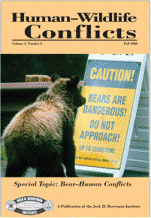Center, Internet, Wildlife Damage Management

Human–Wildlife Interactions
Date of this Version
2008
Document Type
Article
Abstract
Bears (Ursus spp.) that become conditioned to anthropogenic food sources pose a risk to human safety and generally need to be relocated, rehabilitated, or destroyed. Identifying food-conditioned bears may be difficult if the animal is not captured or killed while immediately engaged in the nuisance behavior. Fatty acid signature analysis has been used to examine the dietary habits of bears and other carnivores and is based on the predictable incorporation of ingested fatty acids into the consumer’s fat stores. Unusual fatty acids that are available in only a few food types may be particularly useful dietary markers. In this study, we tested the hypothesis that trans fatty acids present in many processed foods could serve as markers of anthropogenic foraging by black bears (Ursus americanus). Among 13 bears that were killed in western and central Colorado, trans fatty acids were more abundant in conflict bears than in non-conflict bears. Further, the abundance of trans fatty acids in bear fat appeared to be correlated with the intensity of bear–human conflict. We conclude that the trophic transfer of trans fatty acids can provide valuable insights into the ecological, demographic, and anthropogenic factors that contribute to bear–human conflict.


Comments
Published in Human-Wildlife Conflicts Volume 2, Number 2, Pages 183-193, Fall 2008. Published and copyright by Jack H. Berryman Institute. http://www.berrymaninstitute.org/journal/index.html